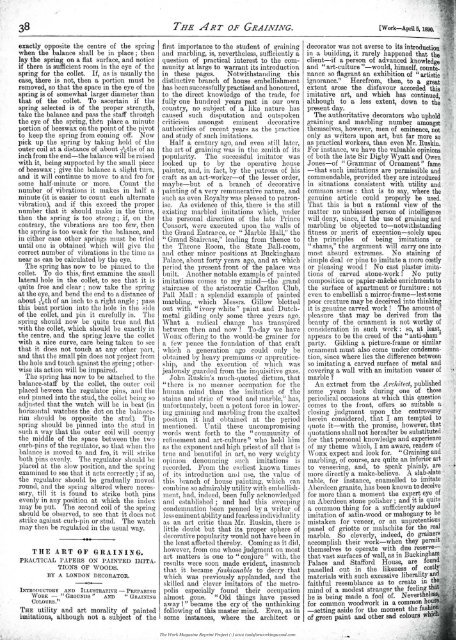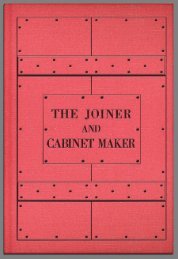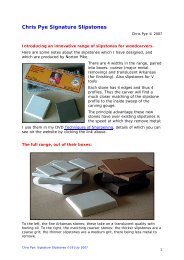Download Vol.2 - No. 55 - Tools for Working Wood
Download Vol.2 - No. 55 - Tools for Working Wood
Download Vol.2 - No. 55 - Tools for Working Wood
You also want an ePaper? Increase the reach of your titles
YUMPU automatically turns print PDFs into web optimized ePapers that Google loves.
T HE ART OF G RAI NING.<br />
[Work-April5, l SlJO. ·•<br />
,<br />
(<br />
exactly opposite the centre of the spring<br />
when the balance shall be in place ; then<br />
lay t he spring on a fiat surface, and notice<br />
if t here is sufficient room in the eye of the<br />
spring <strong>for</strong> the collet. If, as is usually the<br />
case, t here is not, then a portion must be<br />
removed, so that the space in the eye of the<br />
spring is of somewhat larger diameter than<br />
t hat of the collet. To ascertain if the<br />
spring selected is of the proper strength,<br />
take the balance and pa,o:;s the staff throt\gh<br />
the eye of the spring, then place a minute<br />
portion of beeswax on the pomt of the pivot<br />
to keep the spring from coming olf. <strong>No</strong>w<br />
pick up the spring by taking hold of the<br />
outer coil at a distance of about \ 3 , 1 ths of an<br />
inch from the end-the balance wi l be raised<br />
with it, being supported by t he small piece<br />
of beeswax; give the balance a slight turn,<br />
and it will continue to mo,·e to and fro <strong>for</strong><br />
tiOme half-minute or more. Count the<br />
number of vibrations it makes in hn,l£ a<br />
minute (it is easier to count each altemate<br />
Yibration), and if this exceed the proper<br />
number that it should make in the time,<br />
then the spring is too strong ; if, on the<br />
contrary, the v1brations are too few, then<br />
the spring is too weak <strong>for</strong> the ba.l::mce, and<br />
in either case other springs must be tried<br />
until one is obtained which will give the<br />
correct number of vibrations in the time as<br />
near as can be calculated by the eye.<br />
T he spring has now to be pinned to the<br />
collet. To do this,· first examine the small<br />
lateral hole in the collet, to see that it is<br />
quite free and clear; now take the spring<br />
at the eye, and bend the end to a distance of<br />
about ·lrrth of an inch to a right angle ; pass<br />
t his bent portion into the hole in the !';ide<br />
of the collet, and pin it carefully in. The<br />
spring should now be quite true and tlat<br />
with the collet, which should be exactlv in<br />
the centre, and the spring leave the collet<br />
with a nice curve, care being taken to see<br />
that it does not touch at any other pan,<br />
and that the small piu does not project from<br />
t he hole and touch against the spring; otherwise<br />
its action will be impaired.<br />
The spring has now to be attached to the<br />
balance-staff by the collet, the outer coil<br />
placed beween the regulator pins, and the<br />
eucl pinned into the stud, the collet being so<br />
adjusted that the watch will be in beat (in<br />
horizontal watches the dot on the balancerim<br />
should be opposite the stud). The<br />
spring should be pinned into the stud in<br />
such a way that the outer coil will occupy<br />
the middle of the space between the two<br />
curb-pins of the regulator, so that when the<br />
baJance is moved to and fm, it will strike<br />
both pins evenl y. The regulator should be<br />
placed at the slow position, and the spring<br />
examined to see that it acts correctly; if so,<br />
the regulator should be gradually moved<br />
round, and the sprinl? altered where necessary,<br />
till it is found to strike both pins<br />
evenly in auy J?.OSition at which the index<br />
may be put. l'he second coil of the sprinrr<br />
should be observed, to see that it does not<br />
strike against curb-pin or stnd. 'l'he watch<br />
may then be regulated in the usual way.<br />
T liE A. RT OF GRAI N I N G.<br />
PRA()TICAL l '.AI'ERS ON PAINTED IMITA<br />
'l'IONS OF WOODS.<br />
BY A LONDON DECORATOR.<br />
I NTROnUCTORY AND ILLUSTRATIVE- PnF.rARI:s'G<br />
' VonK - "Gnou<strong>No</strong>s '' AND " GnAI::ii~G<br />
COLOURS.''<br />
T HE utility and art morality of painted<br />
imitations, although not a subject of the<br />
first importance to the student of graining<br />
and marbling, is, nevertheless, sufficiently a<br />
question of practical interest to the community<br />
at large to "'arrant its introduction<br />
in these pages. <strong>No</strong>twithstanding this<br />
distinctive branch of house embellishment<br />
has been successfully practised and honout·ed,<br />
to the direct knowledge of the trade, <strong>for</strong><br />
fully one hundred years past in our own<br />
country, no su~j ect of a like nature has<br />
caused such disputation and outspoken<br />
criticism among$t eminent decorative<br />
authorities of recent y ear~ as the practice<br />
and study of such imitations.<br />
Half a century ago, and even still later,<br />
the art of graining was in the zenith of its<br />
popularity. The successful imitator was<br />
looked up to by the operati> e house<br />
painter, and, in fact, by the patrons of his<br />
craft as an art-worker-of the lesser order,<br />
maybe-but of a branch of decorative<br />
painting of a very remunerative nature, and<br />
such as even Hoyalty was pleased to patronise.<br />
As ev-idence of thi ~, there is the still<br />
existing marbled imitations which, under<br />
the personal direction of the hlte Prince<br />
Consort, were executed upon the walls of<br />
the Grand Entrance, or ":Jiarble Hall," the<br />
" Grand Staircase," leading from thence to<br />
the Throne Room, the State Ball-room,<br />
anrl other minor positions at Buckingham<br />
Palace, about <strong>for</strong>ty years ago, and at which<br />
p eriod the present front of the palace was<br />
built. Another notr\.ble example of painted<br />
imitations comes to my mind-the grand<br />
staircase of the aristocratic Carlton Club,<br />
Pall Mall: a splendid example of painted<br />
ma,rbling, which :Jlessrs. Gillow blotted<br />
out with "ivory white" pa,int and Dutchmetal<br />
gilding only some three years ago.<br />
·what a radical change has transpired<br />
between then and now ! To-day we have<br />
WoRK ofl'ering to tbe would-be grainer <strong>for</strong><br />
a few pence the foundation of that craft<br />
which a generation ago could only be<br />
oUtained Ly hen.vy premiums or apprenticeshi<br />
p, and the execution of which was<br />
jealously guarded from the inrtuisitive gaze.<br />
John .R.uskin's much-quoted dictum, that<br />
"there is no meaner occupation <strong>for</strong> the<br />
human mind than the imitation of the<br />
stains and strim of wood and marblei;' has,<br />
un<strong>for</strong>tunately, been a potent furce in owering<br />
graining and marbling from the exalted<br />
po:;ition it had obtainerl at the period<br />
mentioned. Until these uncompromising<br />
words went <strong>for</strong>th to the "community of<br />
refinement and art-cultme" who hold 'him<br />
as the exponent a,nd high pri es ~ of all that i;;<br />
true and beautiful in art, no very weighty<br />
opinion denouncing such imitations i::;<br />
recorded. From the earliest known time:;<br />
of its introduction and use, the Yalue of<br />
thi:; ln·anch of house painting, which can<br />
combine so admirably utility with embellishment,<br />
had, indeed, been fully acknowledged<br />
and e:;tablished; and bad this sweeping<br />
co11demnation been penned by a writer of<br />
less eminent ability and fearless individuality<br />
as an art critic than Mr. Ruskin, there is<br />
little doubt but that its proper sphere of<br />
decorative popularity would not have been in<br />
the least affected t.hereby. Coming as it did,<br />
however, from one whose judgment on most<br />
art matters is one to ''conjure'' with, the<br />
results were soon made evident, inasmuch<br />
that it becau1e fashionable to decry that<br />
which was previously applauded, and the<br />
skilled and clever imitators of the metropolis<br />
especially found their occupation<br />
almost gone. "Old things have passed<br />
away !" became the cry of the untlnnking<br />
following of this master mind. Even, as in<br />
some instances, where the architect or<br />
The Work Magazine Reprint Project (-) 2012 tools<strong>for</strong>workingwood.com<br />
decorator was not averse to its introduction ·<br />
in a building, it rarely happened that the<br />
client-if a person of advanced knowledge<br />
and "art-culture ''-would, himself, counte.<br />
nance so flagrant an exhibition of "artistic<br />
ignorance.'' H erefrom, then, to a. great<br />
extent arose the disfavour accorded this ·<br />
imitative art, and which has continued<br />
although to a less extent, down to th~<br />
present day.<br />
The authoritative decorators who uphold<br />
graining and marbling number amongst ·<br />
themselves, however, men of eminence, not<br />
only as writers upon art, but far more so<br />
as practical workers, than even Mr. Ruskin.<br />
..!!.,or instance, we have the valuable opinions<br />
of both the late Sir Digby Wyatt and Owen<br />
J ones-of " Grammar of Ornament" fame<br />
-that such imitations are permissible and<br />
commendable, provided they are introduced<br />
in situations consistent with utility and<br />
common sense : that is to say, where the<br />
genuine article could properly be used.<br />
That this is but a ratwnal view of the<br />
matter no unbiassed person of intelligence<br />
will deny, since, if the use of graining and<br />
marbling be objected to-notwithstanding<br />
fitness or merit of execution-solely. upon<br />
the principles of being imitations or<br />
"shams," the argument will carry one into<br />
most absurd extremes. <strong>No</strong> staining of<br />
simple deal or pine to imitate a more costly<br />
or pleasing wood ! <strong>No</strong> cast plaster imitations<br />
of carved stone-work! <strong>No</strong> putty<br />
composition or papier-ruacbe enrichments to<br />
the surface of apartment or fumitme : not<br />
even to embellish a mirror-frame-lestsome<br />
poor creature may be deceived into thinking<br />
it is genuine carved work ! The amount of<br />
l<br />
1leasnre that may be derived from the<br />
Jcauty of the ornament is not worthy of<br />
consideration in such work : so, at least,<br />
appears to be the creed of the "anti-sham"<br />
party.<br />
Gilding a picture-frame or similar<br />
ornament must also come under condemnation,<br />
since where lies the difi'erence between<br />
so imitating a carved surface of metal and<br />
coverina a wall with an imitation veneer of<br />
marble 7 ·<br />
An extract from the Arch£tect, published<br />
some years back during one of th?se<br />
periodical occasions at which this quest1on<br />
comes to the front, ofl'ers so suitable o.<br />
closing judgment upon the controversy<br />
herein considered, that I am tempted to<br />
r 1 uote it-with the promise, howeve~, that<br />
quotations shall not hereafter be substt~uted ·<br />
<strong>for</strong> that personal knowledge and expenence<br />
of my t.heme which, I am aw~re, t:ea;ders of<br />
1r onK expect and look <strong>for</strong>.. ' Gr.mmf!g and<br />
marbliwr of course are qmte an mfenor art<br />
01 I I . 1<br />
to veneering, and, to speak p am y, are<br />
more directly a ma.ke-believe. A sl~b-~late<br />
table <strong>for</strong> instance, enamelled to mnt~te<br />
Aber~leeu granite, has been known to decen·e<br />
<strong>for</strong> more than a moment the exp~r~ eye .of<br />
an Aberdeen stone polisher ; and 1t 1s qmte<br />
a common thing <strong>for</strong> a sufficiently subdued<br />
imitation of sa.tin-wood or mahogany t~<br />
mistaken <strong>for</strong> veneer, or an unpretent1vus<br />
panel of griotte or malachite <strong>for</strong> the. real<br />
marble. So cleverly, indeed, do gra.me~s<br />
accomplish their work-when they pernnt-.<br />
themselves to operate with due reservethat<br />
vast surfaces of wall, as in Buckinghamd<br />
Palace and Staf<strong>for</strong>d H ouse, are foun<br />
panelled o~tt in the li~enes~ of . costly<br />
materials With such excess1ve hberah~y abd<br />
faithful resemblance as to create lD. L~<br />
mind of a modest stranger the tlll'<br />
l1e is being made a fool of. N<br />
<strong>for</strong> common woodwork ' in a common hotlS6~<br />
-setting aside <strong>for</strong> the moment the fashiOJ~l<br />
of green paint and other sad colours<br />
•<br />
be<br />
,<br />
•<br />
•<br />
l<br />
I,<br />
I<br />
I'<br />
'<br />
I<br />
I<br />
•<br />
!<br />
I •<br />
I<br />
!<br />
I<br />
•<br />
t<br />
. 1













